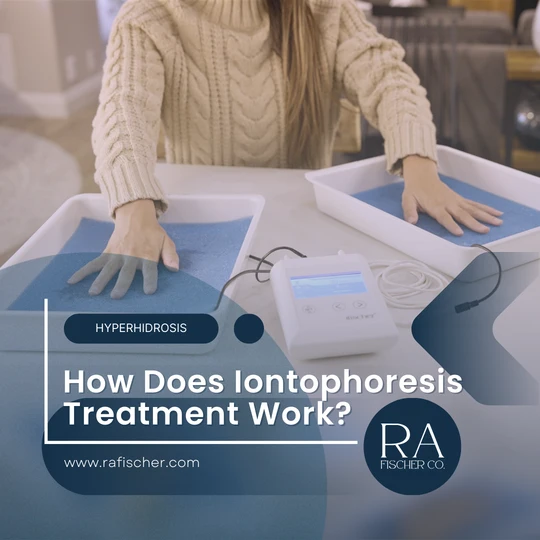February 14, 2024
Common Questions #2: How does iontophoresis treatment work?
How Does Iontophoresis Treatment Work?
The Fischer iontophoresis device boasting a 98% success rate in managing hyperhidrosis. This non-invasive device is safe, effective, and FDA-cleared.
How Iontophoresis Works: The Science Behind It
What Happens During Treatment?
- A mild electrical current is delivered through water to the treatment area, such as hands, feet, or underarms.
- The minerals in tap water are pushed into sweat pores, temporarily blocking sweat glands.
- Sessions typically last 20–30 minutes and are done a few times a week until sweating decreases.
What is Iontophoresis Used For?
A Brief History and Modern Applications
The Fischer iontophoresis device treats:
- Palmar Hyperhidrosis: Sweaty hands.
- Plantar Hyperhidrosis: Sweaty feet.
- Axillary Hyperhidrosis: Excessive underarm sweating.
Are There Any Risks with Iontophoresis?
While iontophoresis is considered safe, minor side effects like tingling may occur during treatment. These sensations typically decrease with use.
Patients with pacemakers, open wounds, or certain medical conditions should consult a doctor before starting treatment. Following proper guidelines ensures a safe and effective experience.
How Long Does Iontophoresis Last?
Why Choose The Fischer Device?
The Fischer iontophoresis device offers a 98% success rate, helping thousands of patients reduce sweating and improve their quality of life.
Innovative Design
Silicone-graphite electrodes ensure safety and durability. Metal-free design eliminates the risk of corrosion or skin irritation. Convenient accessories allow for simultaneous treatment of hands and feet.
Take Control of Your Hyperhidrosis with The Fischer
THE FISCHER
Reach out today
Contact one of our Treatment Specialists today to answer any and all of your questions about the Fischer.
FAQs About Iontophoresis Treatment
How does iontophoresis treatment work?
Iontophoresis uses a mild electrical current to push tap water minerals into sweat glands, temporarily blocking them to reduce excessive sweating.
How effective is iontophoresis for hyperhidrosis?
The Fischer device has a 98% success rate, providing significant relief for most patients.
Is iontophoresis safe?
Yes, iontophoresis is safe when performed correctly with FDA-cleared devices like The Fischer. Consult your doctor if you have a pacemaker or other medical conditions.
Can iontophoresis treat underarm sweating?
Absolutely. The Fischer device is available with attachments to treat underarms effectively.
How long do results from iontophoresis last?
Results can last for weeks with maintenance sessions, making The Fischer iontophoresis device a long-term solution for managing hyperhidrosis.
Leave a Reply Cancel reply
You must be logged in to post a comment.
